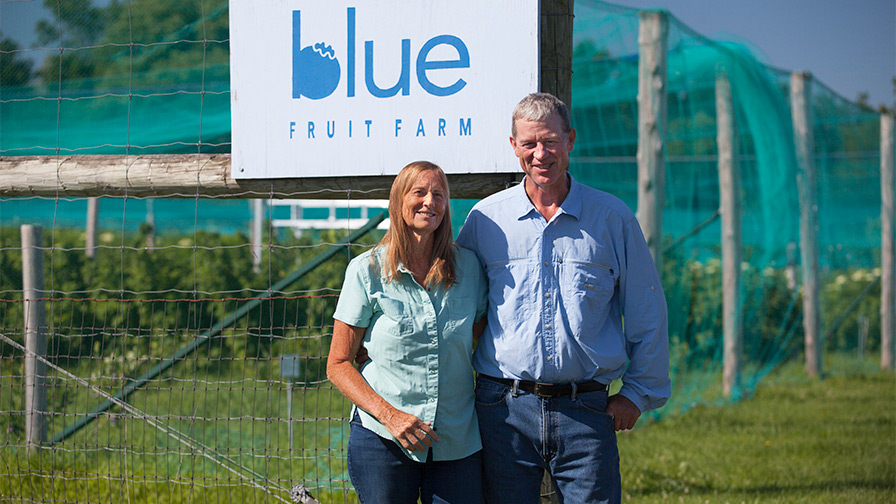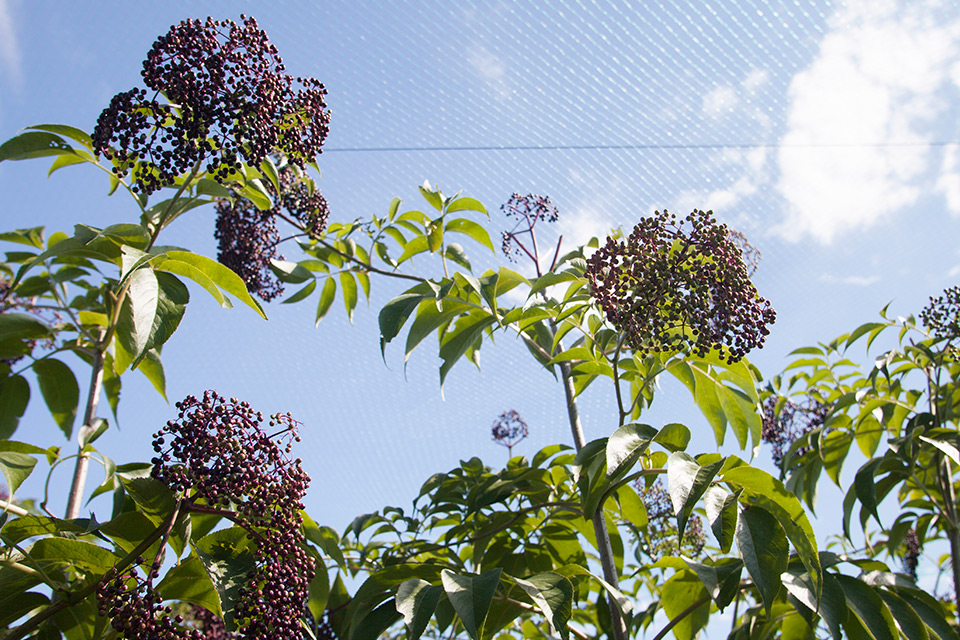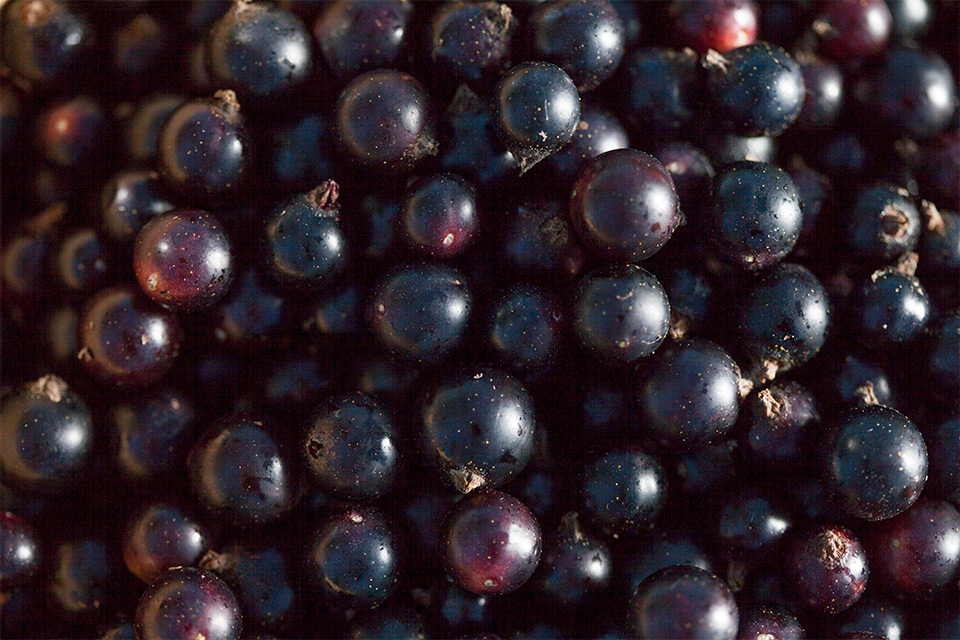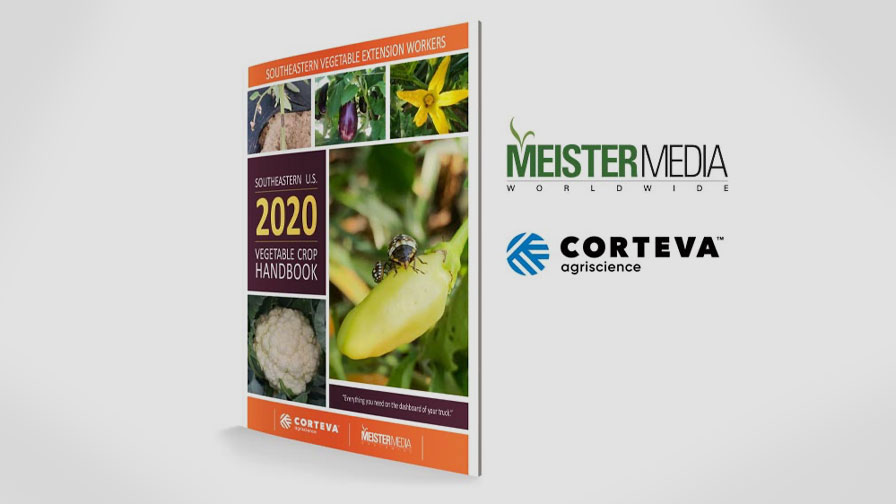Organic Farm on Cutting Edge of New Fruits and Consumer Education

Jim Riddle and Joyce Ford were organic vegetable growers turned organic inspectors and educators until the urge to farm again came calling. The couple grows organic aronia berries, black currants, blue plums, honeyberries, Juneberries, and cherry plums on their 5-acre Blue Fruit Farm in Winona, MN. (Photo: Laurie Schneider)
Blue Fruit Farm in Winona, MN, is anything but a traditional organic berry farm. Jim Riddle and Joyce Ford are pioneers in their state, growing elderberries, aronia berries, honeyberries (or haskap berries), juneberries (or Saskatoon berries), and black currants. They’ve even started to teach their local Extension educators and other growers about the nuances of these crops.
“That’s another exciting part of getting into some of these,” Riddle says. “You’re on the cutting edge of sharing new flavors and information with people.”
But, the story of how Blue Fruit Farm came to be is one of forces colliding.
It’s always been about organic production for Riddle and Ford. In the early 1980s, the couple grew organic vegetables, helped to start a farmers’ market in the Southeast Minnesota town of Winona, and started inspecting organic farms for certification. That led to the couple giving up farming and focusing full time on organic inspection, training, and policy work.
But in 2009, the couple got the urge to farm again. A 5-acre parcel of land they previously farmed became available, and it came with an 8-foot-high deer fence. The couple had agreed with the rental farmer that the fence would stay, even if the farmer pulled out of production.
“We had this 5-acre field protected from deer, just growing weeds. So, Ford said, ‘let’s grow blueberries,’” Riddle says, “That’s what started us on the whole blue fruit adventure.”
Diverse Cropping
While 5 acres may seem like a small endeavor, the couple wanted to farm organically. And Riddle knew the soil pH was not ideal for blueberries, so he amended his soil with compost, peat moss, and elemental sulfur.
“I also advocated trying some other fruits that liked our soil the way it is,” he says.

Riddle has had more success growing elderberry plants on primocane. Once the plants hit dormancy in the fall, he cuts them back to the ground. He says this helps reduce excess vigor and control diseases and pests, too. (Photo: Laurie Schneider)
And so the couple planted more blue fruits, including elderberries, aronia berries, black currants, blue plums, honeyberries, Juneberries, and cherry plums. He says those plantings have been very successful with a top dressing of compost.
“I like to say that blueberries are hard to grow, but they sell themselves. Everybody loves blueberries, everybody is familiar with them. Local certified organic blueberries are a real treat,” he says. “The other things are easy to grow, and we have to sell them because they’re a new taste to the American palate, for the most part.”
Riddle is an encyclopedia of knowledge about the health benefits of currants, honeyberries, elderberries, and aronia berries. But, that’s the nature of his business. Workshops and fruit tasting are part of the game to get people hooked on these healthy fruits.
“One of the reasons we were so interested in these other crops is because they’re packed with flavor and nutrients,” he says. “It’s been an exciting choice of things to grow, breaking new ground, so to speak. But it takes extra work. It’s not something you take to the market and everybody knows it and it’s gone like blackberries, or raspberries, or blueberries.”
Riddle says he’s learned a lot about these plants along the way, but information on how to grow them was a bit scarce when he started. For example, he learned that a variety of black currant — ‘Consort’ — was susceptible to powdery mildew, but another — ‘Titania’ — wasn’t.
“I didn’t want to fight some disease problem on a susceptible plant when I knew there was another variety available that wasn’t susceptible,” he says.
While honeyberries are relatively trouble-free, varietal choice makes a huge difference, he says, like with planting ‘Night Mist’ and ‘MidNightBlue.’
“The fruit was almost inedible — very, very bitter,” he says. “Even though those bushes were very healthy, we pulled them up and planted two varieties, ‘Aurora’ and ‘Beauty,’ that are very tasty and not bitter at all.”

Riddle says black currants (left) have a smoky, musty ‘Cabernet’-like flavor. His initial plantings of currants included the ‘Consort’ variety, which he discovered was very susceptible to powdery mildew, so he replaced it after a year. He says he didn’t want to fight a disease when he knew the other variety he planted, ‘Titania,’ was resistant. (Photo: Laurie Schneider)
Riddle has had more success growing elderberries on primocane, which helps keep the pest and disease pressure down. Pest pressure might be even more of a problem growing plums, he says, making scouting and monitoring crucial.
“A lot of what we do is based on monitoring physical control. For plum curculio (PC), we’ve gone to planting garlic at the base of the trees and then using a garlic foliar spray when traps show that the PC is present because the plum curculio doesn’t like garlic,” Riddle says. “It’s a very integrated approach. Some things take more babysitting. Others are very trouble-free, like the aronia.”
Riddle says aronia is drought-tolerant and has no issues with pest and disease control. On the opposite side, he rigorously prunes his black currants to maintain plant health and productivity.
“Each crop has a different regimen that you learn and adjust,” he says. “Some things work and some things, you go back and try something new.”
SWD Not A Threat
Riddle says spotted wing drosophila (SWD) is present in his area of Minnesota, but he does not grow raspberries, which helps because they are harvested later in the season when SWD is prevalent. Their blueberry harvest is mostly done before SWD pops up.
“We hand harvest, so we’re very thorough in removing fruit from the field. We have a walk-in cooler, so we chill things down right away,” he says. “Even if they’ve laid an egg inside of the fruit, if you chill it down and hold it, that egg never develops.”
He also tips his hat to the biological diversity on and around their farm, which he thinks helps.
“We have quite a bit of native prairie, and we have an incredible native pollinator population — bumblebees, sweat bees, and various wasps,” he says. “We also have very rich predator populations, including spiders. I think the natural ecology helps keep the SWD in check.”
Cultural controls such as pruning blueberries to open up the shady part of the canopy also help minimize pest pressure.
“I think a combination of diversity and management, like pruning and crop selection, has really kept it in check,” he says. “I don’t want to depend on an input application. I want to do everything to prevent and minimize the problem on the front end.”
Class Is in Session
As for growers looking to learn a little more about how and what Riddle does to be successful, he has some specific advice in his own mini-education session:
- Look Before You Leap — Riddle says growers shouldn’t just dive into organic fruit production. In fact, you need to consider many factors before becoming a perennial fruit grower.
“You’ve got to have a plan. You’ve got to have a good site, with good airflow and good drainage,” he says. “We put in irrigation and that’s also really critical, especially for those first two years when things are being established. Thinking about it as a system is really important.” - Don’t Overlook Your Soil — Riddle says organic growers need to pay close attention to the soil conditions in the area they’re going to farm. Cover crops are vital for feeding the soil ecosystem. A critical step is to see what type of soil you’re working with. Do soil tests to determine what micronutrients are needed and what pH is needed for planting.
“Build the soil early on — it’s going pay off forever,” he says. “Organic is really based on healthy soil. You’ve got to start with healthy soil.” - Select the Right Varieties — While Riddle says a few varieties he tried were a mismatch, he’s enjoyed success by scrutinizing disease and pest resistance from the get-go. He also looked for varieties that would thrive on his farm.
“Getting really healthy stock to begin with [helps],” he says. “Looking for resistance in the planting stock is really important for a new grower, especially if you’re going to manage organically and reduce the need for fungicide applications.”
He also suggests growers look at perennial cropping as a relationship.
“You want to have things that you actually enjoy tending, that you’re going to want to go out and take care of,” he says. “There’s personal enrichment. And when you are invested in that relationship, I think there’s a higher chance of success.”
Riddle says organic growers also need to look at planting several crops, and think about what type of food supply is available for pollinators around the farm.
“Diversify, and not just with the crops, but also have understory plantings — things that supply alternative food sources for pollinators.” - Payday Might Not Come Soon — While it’s not glamorous, Riddle says it can’t hurt to take a very close look at your finances and how the choices you make in varieties and types of plants can have a big impact on how early you can start to get into production.
“With perennials, you need to look at how many years you can float the operation before you’re going to have any sort of saleable crop,” he says. “With the blueberries, we made a mistake that we went kind of on the cheap and got bare-root stock that were 12 inches tall for a lot of our blueberries. They survived, but we put three to four years into those before they started producing.” - Start Small and Try Different Things — While Riddle acknowledges organic fruit production was much easier for him to adopt given his background as an organic vegetable grower, he suggests growers start small.
“Don’t be afraid of trying even one block organically,” he says. “If a person is an existing fruit grower, it’s challenging to shift, but doing it a little bit at a time is much more likely to be successful than trying to go cold turkey.”










